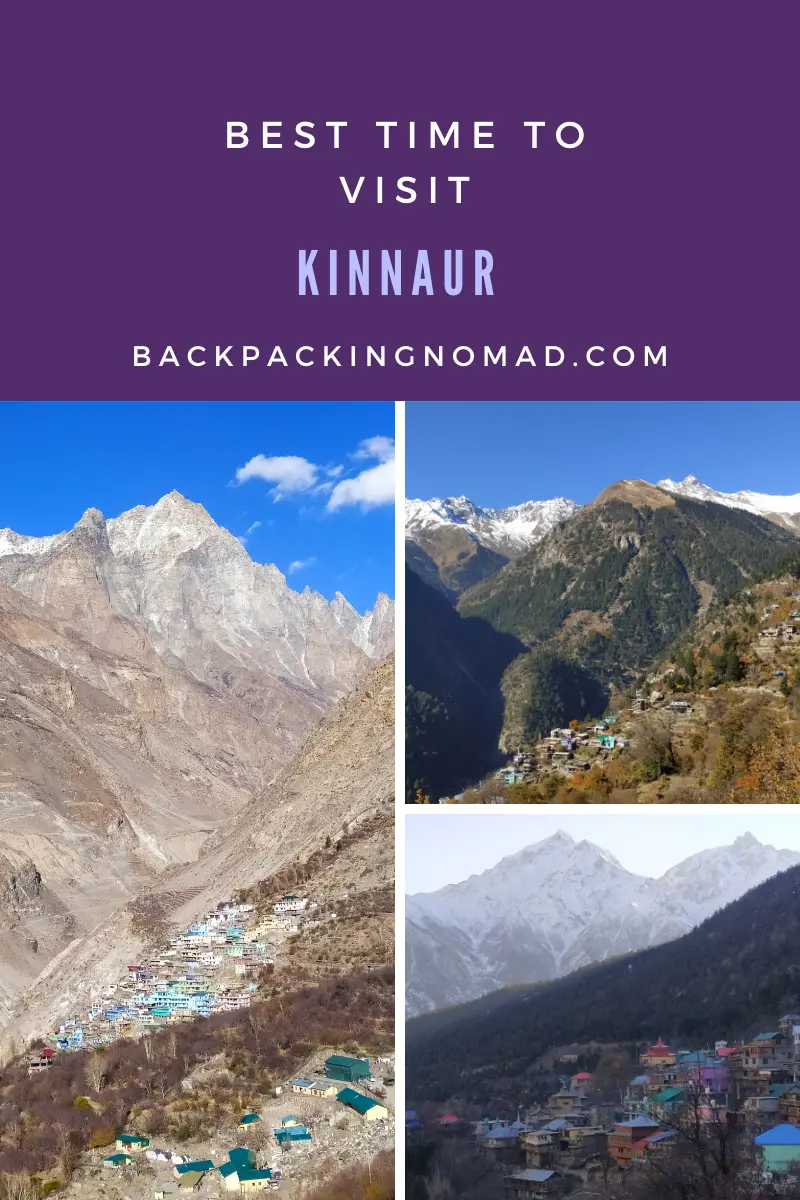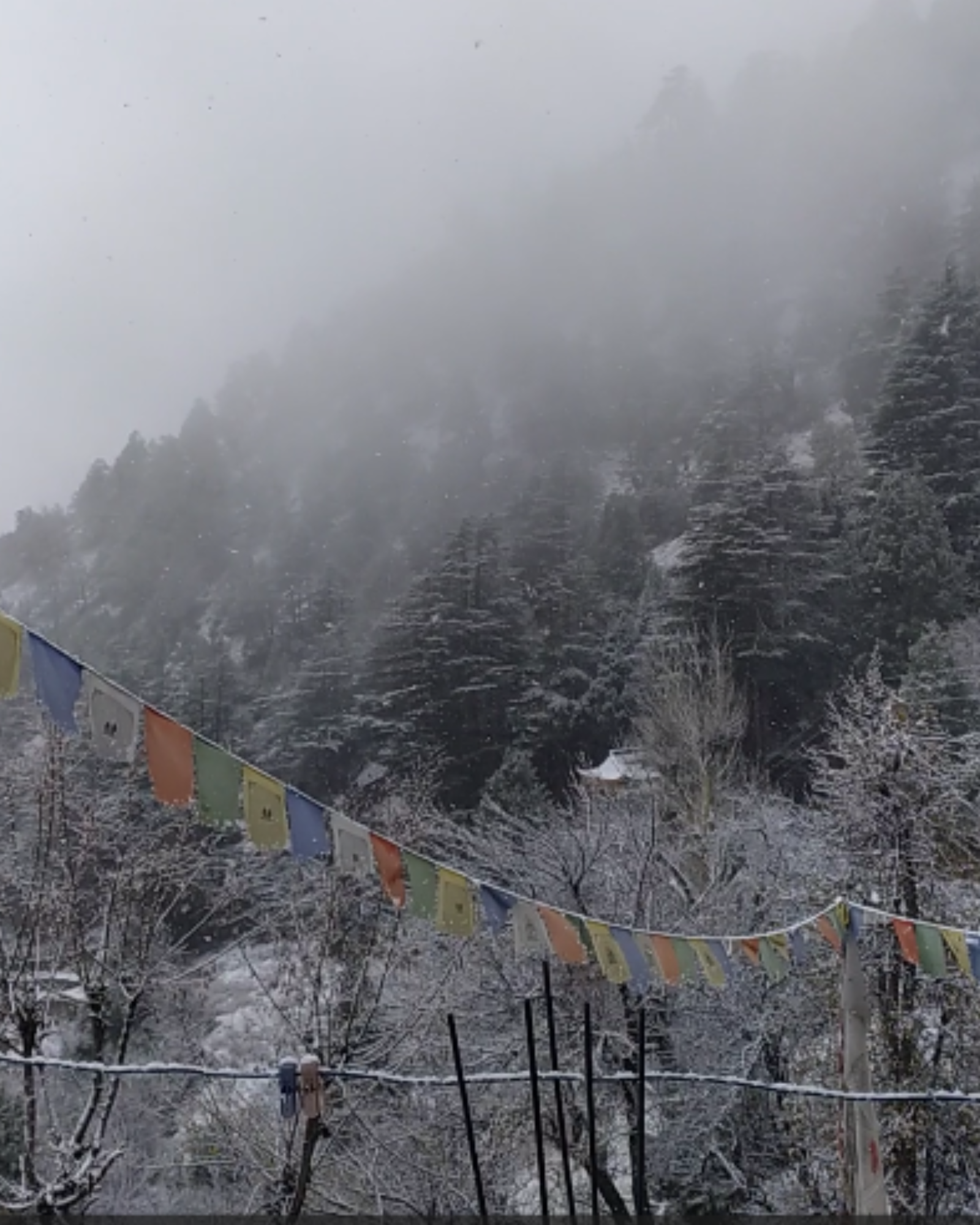The Himalayan wonderland of Kinnaur needs no introduction. The diverse terrain, lofty snowy peaks, eccentric tribal culture, hospitable people entices travelers across globe. And If you have decided to Embark on trip to Kinnaur you certainly would have this question “Best time to visit Kinnaur”
Based on extensive travels in Kinnaur over the past couple years and earlier, I hope to answer your queries around Best time to visit Kinnaur and put them to rest. So lets get started.

Best Time To Visit Kinnaur
To be really honest, the best time to visit Kinnaur or any place for that matter depends on what exactly you are seeking from that trip or the place.
Therefore, in this blog what I’ll be discussing is what to expect for each season in Kinnaur and build on that so that you can decide for yourself what is the best to visit Kinnaur.
First things firsts, Kinnaur experiences a total primary four seasons which are Spring, Summer, Autumn and Winter. While monsoon is additional season in lower Kinnaur. Middle and Upper Kinnaur are rain shadow regions.
Must Read – Kinnaur trip itinerary
Kinnaur In Winter
Best time to visit Kinnaur if you are seeking snowfall and super crisp landscapes is definitely winter. Now depending on which region, the cold and the snow would differ.
But crisp landscapes are a common phenomenon during winters unless there is a prolonged dry spell, which is not an uncommon feature.
A couple of feet of snow is pretty common at places like Sangla, Kalpa and even more in Upper villages if a strong western disturbance affects the western Himalayas.
Although the landscapes are crisp and peaks are snow-covered, the overall terrain appears to be brown during the winter. And also it does not snow all the time during winter.
Snow in the western Himalayas, is caused by western disturbances which originate from Mediterranean sea. Depending on the intensity and frequency of this disturbances the amount of precipitation varies.
Generally winter in Kinnaur starts from Mid-November and continue until Late March. Kinnaur being a district, this window will vary depending upon the altitude and terrain of that place.
Generally at Kalpa and Reckong Peo, the temperatures start falling
The best time to experience experience snowfall is in the January. Thanks to erratic weather for the last couple of seasons, December has turned into late autumn. I’ve personally witnessed this.
All the trees except for Pines, will be in deep slumber and witnessing them devoid of leaves feels like a scene out of horror movie.

Kinnaur in Spring
Again, depending upon the altitude and location, the spring will arrive at different places in different times. Spring is everything starts slowly coming back to life.
But advent of spring doesn’t mean balmy temperatures, lush green landscapes. In fact it can even snow at higher altitudes if there if a strong WD affects the region.
But in general, the trees start coming back to life with flowering commencing. Stone fruit trees are usually first to flower, followed by apple flowering.
Now at altitudes around 2000m, the spring should generally arrive in the first week of March. And higher the altitude, later the spring will arrive.
So you might find flowering at lets say Reckong Peo, but the trees and Kalpa will be still eagerly waiting for the spring to knock on the doors.
Spring is really a sight to behold especially when the flowering is in full flow. The landscape dawning a colorful look with all the colorful flowers seems like somebody has put splashes of colorful in a brown landscape.
Of course, the landscapes are still pretty crisp and clear and remain so unless there is prolonged dry period. In my opinion spring can be a really great time to visit Kinnaur.
The spring starts from early March and lasts till April end at 2000 m altitude. Of course, it will be later at higher altitudes like Kalpa, Nesang, Chitkul, Nako etc.
From the past couple of years though, there have severe heatwaves in Spring. Last year there was a record breaking spring heatwave in March, while this year the situation is even worse and all-time February maximum temperature record has been shattered in Shimla, while Reckong Peo was not too far behind.
Kinnaur in Summer
Delightful Summers are one of the best times to visit not just Kinnaur but any Himalayan region for that matter.
The temperatures are balmy, the brown landscapes slowly start giving way to green, the trees are full of small fruits, trekking and hiking can commence in a full flow and so much more.
But personally I’ve never liked summers. One thing I love the most, to be able to witness the crisp landscapes, which is usually not the case in summers, They tend to be quite hazy to be honest.
Depending on the altitude again, the summer would vary from places to places. But overall you can consider summer to commence from May to August.
Now for places like Chiktul, Asrang, Hango, Nesang, Charang, summers would commence from June until August.
The temperatures are quite balmy, but it can get a bit chilly in the night especially if you are above 2500 m. At Reckong Peo, the maximum temperature would be around 25 degrees while the minimum would be around 14 degrees.
Of course at higher altitudes, the temperatures would be lower.

Kinnaur In Monsoon
Now most part of Kinnaur does not experience unlike the rest of Himachal except for lower Kinnaur. Therefore, those lush green vistas are usually somewhat milder in places beyond Reckong Peo.
Himachal experiences heavy monsoon rains only from Mid July until Early September and lower Kinnaur is no different. Middle Kinnaur, Upper Kinnaur and Baspa valley do get rains but negligible compared to lower Kinnaur.
But that doesn’t mean that extreme events can be ruled out. Cloudburst evens have become common-place in Kinnaur especially in the recent years even in rain shadow areas.
Also, the stretch from Nigulsari to Wangtu is landslide prone, which has often resulted in terrible tragedies over the recent years.
In 2022, I happen to be in Kinnaur at the time when monsoon was active in Himachal. While the areas I visited were mostly beyond Peo and I stayed mostly in Peo, so there were negligible rains.
But the moment I crossed, Wangtu towards lower Kinnaur and Rampur, the rains picked up and it seemed really scary to travel in such conditions.
But again a lot of people plan their Spiti trips via Kinnaur in peak monsoon. The landslides will not be an issue beyond Reckong Peo and even Spiti, but mainly in the stretch I pointed out. So keep a constant check on the forecast if you are going in monsoon.
Monsoon is really good time to take it slow rather then hopping from one place to another in Kinnaur or Himachal in general. Landslide events have been a widespread phenomenon in the monsoon in the Himalayas.
Kinnaur in Autumn
If you would ask me, Autumn is my favourite and also one of the best times to visit Kinnaur. The rains are behind and so is the danger of landslides.
The landscapes are start turning super-crisp and in fact, post Septmeber when skies becoming cloudless as Autumn annouces its arrival.
The short early Autumn window is one of the best times to embark on high-altitude treks, but only after checking the forecasts.
The temperatures are pretty comfortable. The days are pleasant and the nights and mornings are cold. The trees begin to turn golden giving way to beautiful autumnal landscapes with crystal clear skies.
The autumn in Kinnaur commences from September end and continues until Mid-November. Now depending upon the altitude again, this window will vary and Autumn will give way to winter much quicker in high-altitude villages of Kinnaur.
But again, my fondest memories of Kinnaur have been from the Late autumn trip to Kinnaur in 2021. The super crisp skies, clear view of peaks were the highlights climate and landscape wise.
The maximum temperature should be around 18 degrees and minimum around 5 degrees at district headquarters of Reckong Peo in proper Autumn.
The temperature start to plummet as Autumn progress and hover around sub-zero with late autumn giving way to winter. And the trees slowly start shedding their leaves to bid a goodbye until the advent of spring breathes fresh life into them.


